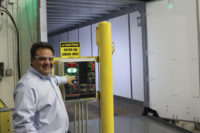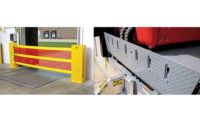Slow down & watch out: Know the FACTS about loading dock hazards

Loading docks are the behind-the-scenes settings for essential operations of businesses everywhere. They are, by no means, exempt from their fair share of accidents and injuries. Twenty-five percent of all industrial accidents occur at the loading dock. And for each accident that occurs, there are about 600 near-misses. Loading docks are flooded with potential danger, and without the proper training, procedures, equipment, and maintenance they are liable to deliver disaster at every turn.
What is the best defense against such a threat? Knowledge. Since January 1st, 2017, 14 people have been injured from loading dock accidents, nine of which were fatalities.
The United States Department of Labor and OSHA have recommended that workers “slow down, watch out for others, and be aware of the edge of the dock” when operating a forklift on a loading dock. (You can research the official regulation 1910.23(b) protection for wall openings and holes or the American National Standards Institute (ANSI) A1264.1-2007, “Safety Requirements for Workplace Walking/Working Surfaces and Their Access; Workplace, Floor, Wall, and Roof Openings; Stairs and Guardrails Systems.”) Many times the requirements will allow a simple chain or hardware that can withstand at least 200 pounds of force.
Securing the dock environment
The loading dock chain is a problem, though, as it will not stand up to the hours of beating that your loading dock takes on a daily basis. For example, a simple chain will not hold back a 13,100-pound forklift traveling at four miles per hour, nor will it stop someone from tripping over the loading dock edge. In fact, a single chain cannot even deter crawl-under attempts.
Another issue that can be found in many warehouses, loading docks, and industrial settings is a lack of safety netting, for example racking and rack netting along inventory shelves.
Hunt for hazards
So, how can you go about correcting the safety and security of your loading dock? We can break down loading dock accidents into four different categories. We refer to these as FACTS:
- Forklift Accidents
- Attention and Alertness
- Carbon Monoxide Poisoning
- Trailer Creep
- Slips, Trips, and Falls
Forklift accidents
The most dangerous items on your loading dock are the machinery. Many loading docks operations move very quickly, like an expertly-directed play or well-oiled machine. All the cogs fit together, that is, until someone drops a wrench in the machine itself. Forklifts can easily topple, fall off edges, or knock smaller items around. Every year over 94,000 people are injured by forklifts. Injuries like this can be very costly for a business, not only for the physical toll they take on employees, but also for the damage they cause to equipment, property, or delayed production.
Attention and alertness
As stated previously, loading docks often function like a well-oiled machine. What happens to the machine if just one part is out of sync? Say, for example, someone is tired or sluggish. If an individual gets less than 8-10 hours of sleep per night, they are susceptible to be fatigued. In very fast-paced environments such as manufacturing warehouses or loading docks, common fatigue can be costly. For example, just by receiving less than eight hours of sleep per night American workers are 38 percent more likely to be injured in the workplace. Workers function more safely and efficiently by staying awake, remaining alert, and taking periodic breaks.
Carbon monoxide poisoning
Carbon monoxide is the colorless, odorless gas that seems to billow into loading docks during loading and unloading of vehicles. Poorly ventilated areas of a warehouse can quickly become home to an undetectable cloud of poison. The burning of fuel can easily replace the air we breathe with something much deadlier. The best way to combat this loading dock issue is through proper ventilation and the installation of carbon monoxide alarms. Keeping both the ventilation and the alarms up to date, tested, and working is essential. Your employees will also need to know what to do if and when an alarm sounds. This can be achieved through training and awareness of carbon monoxide.
Trailer creep
One of the most frequent accidents that take place in the loading dock area is fall-through, particularly when trucks separate from the loading dock. Many devices such as wheel chocks or other vehicle restraints attempt to prevent rolling or movement of the truck while backing into the loading dock; however, many times communication or human error can leave the vehicle improperly secured. Workers can discover and fix these issues more quickly with the help of a dock leveler, but sometimes employees overlook the attention that should be brought to loading docks
Slips, trips, and falls
Finally, slips, trips, and fall hazards are probably one of the most common in any business or retail store. While wet signs or dangerous area markers are intended to deter this, they’re often overlooked or passed without a thought; however, many barriers, gates, and guardrails are on the market today to stop workers from entering dangerous areas. For example, on a snowy day when the loading dock is wet, cold, and slippery a truck pulls up as a forklift rushes to the open door to unload. The forklift skids right over the loading dock or right into another worker. Accidents like this can be widespread and exceptionally dangerous.
In conclusion, the loading dock area is a hazardous area and can make for a near war zone for many individuals without the proper training and safety equipment. By following the appropriate safety rules and looking out for your safety as well as that of your fellow employees, you can make the loading dock a safer worksite.
Looking for a reprint of this article?
From high-res PDFs to custom plaques, order your copy today!






